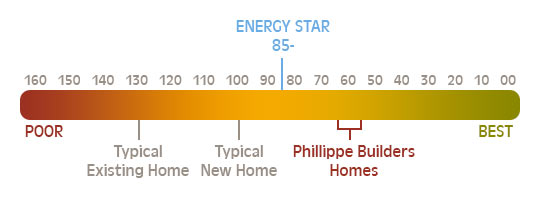How Phillippe Builders’ Green Homes Outperform Energy Code: Prescriptive versus Performance Method
When it comes to energy efficiency and building green homes, there are two ways to meet code requirements: the prescriptive method and the performance method. A prescriptive code requires that each component be built to a certain standard, for example R-38 ceiling insulation. By building with all of the prescribed ingredients, a builder can meet code. A performance path to code compliance allows a builder to customize their energy efficiency components. An independent third-party tester verifies that the home will consume less energy than a house built on the prescribed path. Phillippe Builders follows this performance path, and has a proven track record of outperforming the energy code for green homes with style.
RESNET & HERS Index
The HERS Index (Home Energy Rating System) is a scoring system established by the Residential Energy Services Network (RESNET) and is the official measure of energy performance by the US Department of Energy. The lower the HERS Index, the more energy efficient the home is. An average HERS score for a home built to code ten years ago is 130. A home built to the 2006 International Energy Conservation Code represents an index of 100. Each 1-point decrease in the HERS Index corresponds to a 1% reduction in energy consumption. For example, a home with a HERS index of 60 is 40% more energy efficient than a HERS Reference Home.
What an Energy Efficient Home Means to You and Your Family
- More even temperatures throughout the house
- Increased comfort
- Lower energy bills
- Smaller carbon footprint
- Reduced air pollution
- Potential green home tax credits
- Less money paid in utilities translates to you having greater buying power.
DID YOU KNOW? Banks recognize that your $50 a month utility bill savings enables you to put that money toward your mortgage payment. In a 30 year mortgage, that means you can borrow $10,000 more on a home.

